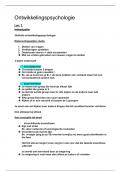Inhoud
1. D1 Inleidende Begrippen & Methodologische Overwegingen ........................................................ 4
1.1. Intro & Marktonderzoek (H1).................................................................................................. 4
INTRO & TYPES MO ........................................................................................................................... 4
MO & MIS ....................................................................................................................................... 9
EVOLUTIES & UITDAGINGEN ............................................................................................................... 9
1.2. Goed Marktonderzoek (H2) (2.1 – 2.5) ................................................................................. 10
A. GOED ONDERZOEK .................................................................................................................... 10
B. WETENSCHAPPELIJK KARAKTER MO .......................................................................................... 11
C. WANNEER WEL OF NIET ONDERZOEKEN? ................................................................................... 15
D. ETHISCHE PROBLEMEN MO ....................................................................................................... 17
E. OVERKOEPELENDE ORGANISATIE MO ........................................................................................ 17
1.3. Onderzoeksplan (H3) ............................................................................................................. 17
1.4. De Probleemstelling (H4) (1-2) .............................................................................................. 18
HIËRARCHIE V/D PROBLEEMSTELLING ................................................................................................ 18
EXPLICITEREN VAN PROBLEEMSTELLING & ONDERZOEKSVRAAG ........................................................... 19
2. D2 Gegevensverzameling (H5 – H11) ............................................................................................ 20
2.1. Secundaire Gegevens (H5) .................................................................................................... 20
INTRO .............................................................................................................................................. 20
INTERNE SECUNDAIRE GEGEVENS ...................................................................................................... 21
EXTERNE SECUNDAIRE GEGEVENS ...................................................................................................... 21
2.2. Steekproeftrekking (H6) ........................................................................................................ 23
INTRO .............................................................................................................................................. 23
STAPPEN IN STEEKPROEFPROCES & FOUTBRONNEN ............................................................................ 24
SOORTEN STEEKPROEVEN ................................................................................................................. 26
NIET PROBABILISTISCHE STEEKPROEFPROCEDURE ............................................................................... 27
PROBABILISTISCHE STEEKPROEFPROCEDURE ....................................................................................... 29
BEPALEN V/D STEEKPROEFOMVANG .................................................................................................. 31
2.3. Kwalitatief Onderzoek (H7) ................................................................................................... 32
INTRO .............................................................................................................................................. 32
EXPLORATIEVE INTERVIEWS ............................................................................................................... 33
PROJECTIEVE TECHNIEKEN ................................................................................................................. 40
ANALYSE TECHNIEKEN KWALITATIEF ONDERZOEK ................................................................................ 41
2.4. Observatie & Ondervraging (H8) ........................................................................................... 43
, INTRO .............................................................................................................................................. 43
TYPES INFO ...................................................................................................................................... 43
GEGEVENSVERZAMELING .................................................................................................................. 46
OBSERVATIETECHNIEKEN ................................................................................................................... 46
ONDERVRAGINGSTECHNIEKEN ........................................................................................................... 51
COMMUNICATIEMETHODEN BIJ ONDERVRAGING ................................................................................ 53
INTERNET ALS ONDERVRAGINGSINSTRUMENT ..................................................................................... 55
2.5. Opstellen van Vragenlijsten (H9) ........................................................................................... 57
INTRO .............................................................................................................................................. 57
INHOUD V/D VRAGEN ....................................................................................................................... 59
VORM ............................................................................................................................................. 62
VERWOORDING ................................................................................................................................ 64
VOLGORDE ...................................................................................................................................... 66
VOORBEREIDING .............................................................................................................................. 67
2.6. Schaalmeting (H10) ............................................................................................................... 68
INTRO .............................................................................................................................................. 68
SOORTEN SCHALEN ........................................................................................................................... 69
UNIDIMENSIONELE SCHALEN ............................................................................................................. 71
MULTIDIMENSIONELE SCHALEN ......................................................................................................... 73
INTERNE CONSISTENTIE ..................................................................................................................... 77
TECHNISCHE BESLISSINGEN ................................................................................................................ 78
2.7. Causaal Onderzoek: Experiment opzetten (H11) .................................................................. 79
INTRO .............................................................................................................................................. 79
TYPES EXPERIMENT (3) ..................................................................................................................... 80
SOORTEN OPZETTEN ......................................................................................................................... 82
CASE 1: VR IN ADVERTISING (THE NORTH FACE) ............................................................................... 84
CASE 2: INVLOED VR OP AANKOOPINTENTIE ...................................................................................... 86
CASE 3: VR IN WINKELCENTRA (2X2 FACTORIËEL ) .............................................................................. 86
AANDACHTSPUNTEN ......................................................................................................................... 88
3. D3 Gegevensanalyse...................................................................................................................... 90
3.1. Univariate technieken (H12) ................................................................................................. 90
ANALYSEREN VAN GEGEVENS ............................................................................................................ 90
DESCRIPTIEVE STATISTIEK .................................................................................................................. 90
HYPOTHESETESTEN ........................................................................................................................... 95
STATISTISCHE TOETSEN ..................................................................................................................... 96
3.2. Multivariate technieken (H13) ............................................................................................ 104
, AFHANKELIJKE VARIABELE ? (AV) ..................................................................................................... 104
INTERDEPENDENTIE TECHNIEK ......................................................................................................... 104
DEPENDENTIETECHNIEKEN .............................................................................................................. 104
MEETNIVEAU ................................................................................................................................. 105
3.3. Kruistabellen (H14) .............................................................................................................. 105
INTRO ............................................................................................................................................ 105
AARD & DOEL METHODE ................................................................................................................. 105
INTERPRETATIE ............................................................................................................................... 106
STATISTISCHE SIGNIFICANTIE VAN ASSOCIATIE .................................................................................. 109
ASSOCIATIEMATEN ......................................................................................................................... 110
ORDINALE ASSOCIATIE /RANGORDE .................................................................................................. 111
INTERVAL OF RATIO NIVEAU ............................................................................................................ 111
OEF .............................................................................................................................................. 111
3.4. Variantieanalyse (H15) (meer dan 2 SP).............................................................................. 112
AARD & DOEL METHODE ................................................................................................................. 112
WERKWIJZE & RESULTATEN ; VOLLEDIG ASELECTE OPZET ................................................................... 113
MEERVOUDIGE CLASSIFICATIE (INTERACTIE -EFFECTEN) ...................................................................... 114
WITHIN SUBJECT OPZET .................................................................................................................. 116
VERKLARINGSKRACHT ..................................................................................................................... 117
INTERVAL OF RATIO NIVEAU ............................................................................................................ 117
3.5. Exploratieve factoranalyse (FA) (H18) ................................................................................. 118
AARD, DOEL EN BASISGEGEVENS METHODE ...................................................................................... 118
DEFINITIE & INTERPRETATIE COMPONENTENSTRUCTUUR (PCA) ........................................................ 120
3.6. Clusteranalyse (CA) (H19) .................................................................................................... 124
AARD & DOEL METHODE ................................................................................................................. 124
SELECTIE , MEETNIVEAU & VERGELIJKBAARHEID V /D ATTRIBUTEN ....................................................... 125
KEUZE SIMILARITEITS -DISSIMILARITEIT OF AFSTANDSINDEX ............................................................... 126
CLUSTER ALGORITMES .................................................................................................................... 127
BEPALEN VAN OPTIMAAL AANTAL CLUSTERS & EVALUATIE V /D STRUCTUUR ........................................ 129
4. D4 Toepassingen (NIET)............................................................................................................... 131
5. Examen ........................................................................................................................................ 132
, 0. Praktisch
Lessen HOC
- Opgenomen + on campus
WPO
- Verplicht on campus
- 5/10 switchen van HOC & WPO
Groepswerk
- Per 6 → groep inschrijven 30/09/2022 om 13u
- Rapport + presentatie
- Top 5 via Qualtrics-link
- Toekenning topic + gedetailleerde uitleg = 6/10
- Opdrachtgever heeft zeg in topic
- Per opdrachtgever, enkele topics en vraagstukken → max 2 vraagstukken kiezen
- Overzicht Deadlines op excel maken
Mogelijke topics
- Courjette (8)
- Solid Datakluizen (12)
- Univ. VL (16 – 17)
- Zuivel-alternatieven (21)
1. D1 Inleidende Begrippen & Methodologische
Overwegingen
1.1. Intro & Marktonderzoek (H1)
OVERZICHT
A. Intro & Types MO
B. MO & MIS
C. Evoluties & Uitdagingen
INTRO & TYPES MO
Ondoordacht OF geen MO
- Strijd tussen Coca Cola & Pepsi
- Smaaktest → pepsi was lekkerder
- Reactie Cola: nieuw recept gelanceerd en dat recept was wel degelijk lekkerder dan Pepsi
- MAAR: sales en Public relations ramp, want klanten hechten veel belang aan de nostalgie &
verbondenheid van de originele Cola-smaak
- Gevolg: klanten hebben Cola zelf geboycot










